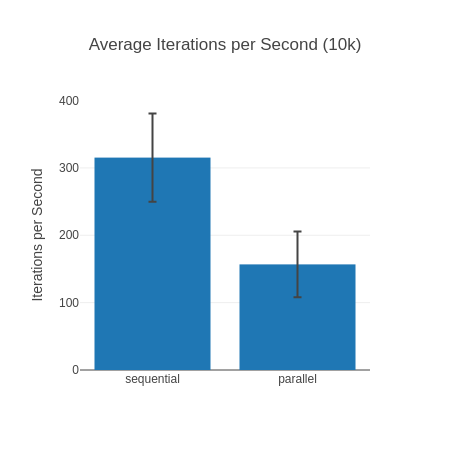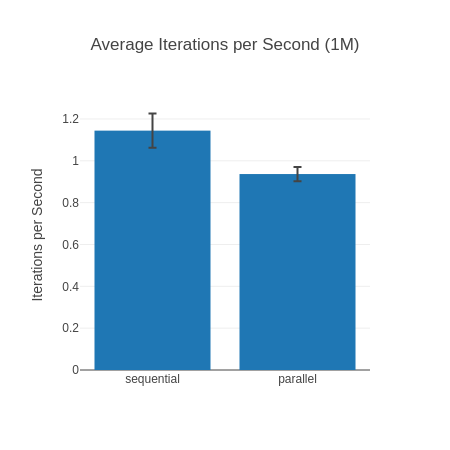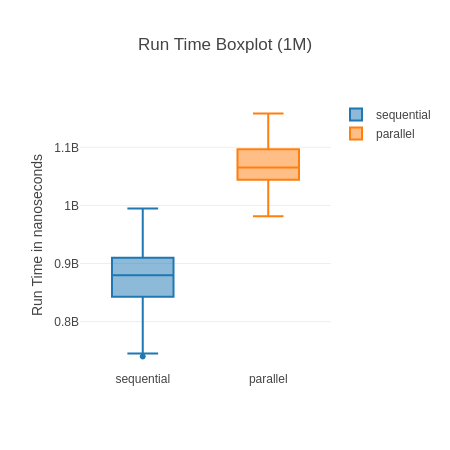In Elixir and on the BEAM (Erlang Virtual Machine) in general we love our processes – lightweight, easily run millions of them, easy lock-less parallelism – you’ve probably heard it all. Processes are great and one of the many reasons people gravitate towards the BEAM.
Functions like Task.async/1 make parallelism effortless and can feel almost magical. Cool, let’s use it in a simple benchmark! Let’s create some random lists, and then let’s run some non trivial Enum functions on them: uniq, frequencies and shuffle and let’s compare doing them sequentially (one after the other) and running them all in parallel. This kind of work is super easy to parallelize, so we can just fire off the tasks and then await them:
Cool, let’s check out the results! You can check the HTML report online here, uncollapse for the console formatter version or just check out the pictures.
Console formatter output
Operating System: Linux
CPU Information: AMD Ryzen 9 5900X 12-Core Processor
Number of Available Cores: 24
Available memory: 31.25 GB
Elixir 1.16.0-rc.1
Erlang 26.1.2
JIT enabled: true
Benchmark suite executing with the following configuration:
warmup: 15 s
time: 1 min
memory time: 0 ns
reduction time: 0 ns
parallel: 1
inputs: 10k, 1M, 10M
Estimated total run time: 7.50 min
##### With input 10k #####
Name ips average deviation median 99th %
sequential 315.29 3.17 ms ±20.76% 2.96 ms 5.44 ms
parallel 156.77 6.38 ms ±31.08% 6.11 ms 10.75 ms
Comparison:
sequential 315.29
parallel 156.77 - 2.01x slower +3.21 ms
Extended statistics:
Name minimum maximum sample size mode
sequential 2.61 ms 7.84 ms 18.91 K 2.73 ms, 3.01 ms
parallel 3.14 ms 11.99 ms 9.40 K4.80 ms, 4.87 ms, 8.93 ms
##### With input 1M #####
Name ips average deviation median 99th %
sequential 1.14 0.87 s ±7.16% 0.88 s 0.99 s
parallel 0.94 1.07 s ±3.65% 1.07 s 1.16 s
Comparison:
sequential 1.14
parallel 0.94 - 1.22x slower +0.194 s
Extended statistics:
Name minimum maximum sample size mode
sequential 0.74 s 0.99 s 69 None
parallel 0.98 s 1.16 s 57 None
##### With input 10M #####
Name ips average deviation median 99th %
sequential 0.0896 11.17 s ±10.79% 11.21 s 12.93 s
parallel 0.0877 11.40 s ±1.70% 11.37 s 11.66 s
Comparison:
sequential 0.0896
parallel 0.0877 - 1.02x slower +0.23 s
Extended statistics:
Name minimum maximum sample size mode
sequential 9.22 s 12.93 s 6 None
parallel 11.16 s 11.66 s 6 None
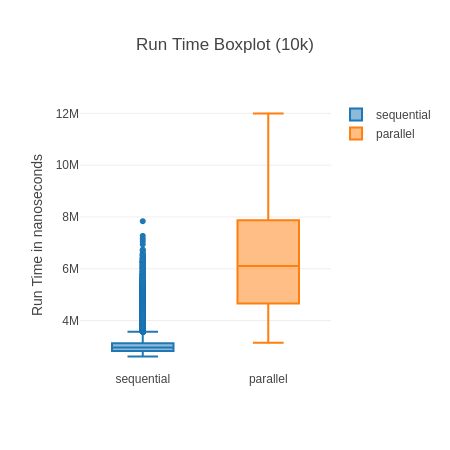
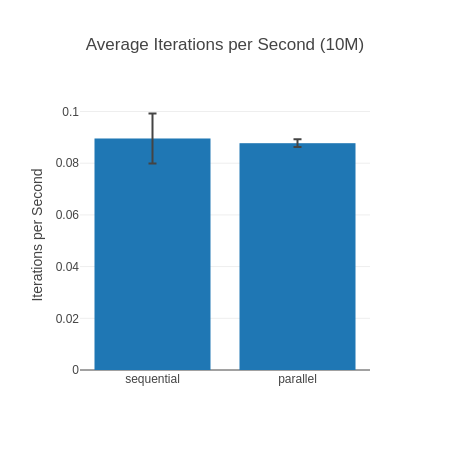
And just as we all expected the parallel… no wait a second the sequential version is faster for all of them? How could that be? This was easily parallelizable work, split into 3 work packages with many more cores available to do the work. Why is the parallel execution slower?
What happened here?
There’s no weird trick to this: It ran on a system with 12 physical cores that was idling save for the benchmark. Starting processes is extremely fast and lightweight, so that’s also not it. By most accounts, parallel processing should win out.
What is the problem then?
The problem here are the huge lists the tasks need to operate on and the return values that need to get back to the main process. The BEAM works on a “share nothing” architecture, this means in order to process theses lists in parallel we have to copy the lists over entirely to the process (Tasks are backed by processes). And once they’re done, we need to copy over the result as well. Copying, esp. big data structures, is both CPU intensive and memory intensive. In this case the additional copying work we do outweighs the gains we get by processing the data in parallel. You can also see that this effect seems to be diminishing the bigger the lists get – so it seems like the parallelization is catching up there.
The full copy may sound strange – after all we’re dealing with immutable data structures which should be safe to share. Well, once processes share data garbage collection becomes a whole other world of complex, or in the words of the OTP team in “A few notes on message passing” (emphasis mine):
Sending a message is straightforward: we try to find the process associated with the process identifier, and if one exists we insert the message into its signal queue.
Messages are always copied before being inserted into the queue. As wasteful as this may sound it greatly reduces garbage collection (GC) latency as the GC never has to look beyond a single process. Non-copying implementations have been tried in the past, but they turned out to be a bad fit as low latency is more important than sheer throughput for the kind of soft-realtime systems that Erlang is designed to build.
John Högberg
Robert Virding (co-inventor of Erlang) also puts some more color to it in a thread on elixir forum.
In case you’re interested in other factors for this particular benchmark: I chose the 3 functions semi-randomly looking for functions that traverse the full list at least once doing some non trivial work. If you do heavier work on the lists the parallel solution will fare better. We can also not completely discount that CPU boosting (where single core performance may increase if the other cores are idle) is shifting benchmark a bit in favor of sequential but overall it should be solid enough for demonstration purposes. Due to the low sample size for the 10M list, parallel execution may sometimes come out ahead, but usually doesn’t (and I didn’t want the benchmark take even longer).
The Sneakyness
Now, the problem here is a bit more sneaky – as we’re not explicitly sending messages. Our code looks like this: Task.async(fn -> Enum.uniq(big_list) end) – there is no send or GenServer.call here! However, that function still needs to make its way to the process for execution. As the closure of the function automatically captures referenced variables – all that data ends up being copied over as well! (Technically speaking Task.async does a send under the hood, but spawn/1 also behaves like this.)
This is what caught me off-guard with this – I knew messages were copied, but somehow Task.async was so magical I didn’t think about it sending messages or needing to copy its data to a process. Let’s call it a blind spot and broken mental model I’ve had for way too long. Hence, this blog post is for you dear reader – may you avoid the mistake I made!
Let’s also be clear here that normally this isn’t a problem and the benefits we get from this behavior are worth it. When a process terminates we can just free all its memory. It’s also not super common to shift so much data to a process to do comparatively lightweight work. The problem here is a bit, how easy it is for this problem to sneak up on you when using these high level abstractions like Task.async/1.
Real library, real problems
Yup. While I feel some shame about it, I’ve always been an advocate for sharing mistakes you made to spread some of the best leanings. This isn’t a purely theoretical thing I ran into – it stems from real problems I encountered. As you may know I’m the author of benchee – the best benchmarking library ™ 😉 . Benchee’s design, in a nut shell, revolves around a big data structure – the suite – data is enriched throughout the process of benchmarking. You may get a better idea by looking at the breakdown of the steps. This has worked great for us.
However, some of the data in that suite may reference large chunks of data if the benchmark operates on large data. Each Scenario references its given input as well as its benchmarking function. Given what we just learned both of these may be huge. More than that, the Configuration also holds all the configured inputs and is part of the suite as well.
Now, when benchee tries to compute your statistics in parallel it happily creates a new process for each scenario (which may be 20+) copying over the benchmarking function and input although it really doesn’t need them.
Even worse formatters are run in parallel handing over the entire suite – including all scenarios (function and input) as well as all the inputs again as part of the Configuration – none of which a formatter should need. 😱
To be clear, you will only encounter this problem if you deal with huge sets of data and if you do it’s “just” more memory and time used. However, for a library about measuring things and making them fast this is no good.
The remedy
Thankfully, there are multiple possible remedies for this problem:
- Limiting the data you send to the absolute necessary minimum, instead of just sending the whole struct. For example, don’t send an entire
Suitestruct if all you need is a couple of fields. - If only the process needs the data, it may fetch the data itself instead. I.e. instead of putting the result of a giant query into the process, the process could be the one doing the query if it’s the only one that needs the data.
- There are some data structures that are shared between processes and hence don’t need copying, such as ets and persistent_term.
As teased above, the most common and easiest solution is just to pass along the data you need, if you ended up accidentally sending along more than you wanted to. You can see one step of it in this pull request or this one.
The results are quite astounding, for a benchmark I’m working on (blog post coming soon ™) this change got it from practically being unable to run the benchmark due to memory constraints (on a 32GB RAM system) to easily running the benchmark – maximum resident size set size got almost halfed.
The magnitude of this can also be shown perhaps by the size of the files I saved for this benchmark. Saving is actually implemented as a formatter, and so automatically benefits from these changes – the file size for this benchmark went down from ~200MB per file to 1MB aka a reduction to 0.5% in size. You can read more about how it improved in the benchee 1.3.0 release notes.
Naturally this change will also make its way to you all as benchee 1.3.0 soon (edit: out now!).
Also when pursuing to fix this be mindful that you need to completely remove the variable from the closure. You can’t just go: Task.async(fn -> magic(suite.configuration) end) – the entire suite will still be sent along.
iex(1)> list = Enum.to_list(1..100_000)
iex(2)> # do not benchmark in iex, this is purely done to get a suite with some data
iex(3)> suite = Benchee.run(%{map: fn -> Enum.map(list, fn i -> i * i end) end })
iex(4)> :erts_debug.size(suite)
200642
iex(5)> :erts_debug.size(fn -> suite end)
200675
iex(6)> :erts_debug.size(fn -> suite.configuration end)
200841
iex(7)> :erts_debug.size(fn -> suite.configuration.time end)
201007
iex(8)> configuration = suite.configuration
iex(9)> :erts_debug.size(fn -> configuration.time end)
295
iex(10)> time = configuration.time
iex(11)> :erts_debug.size(fn -> time end)
54
Helping others avoid making the same mistake
All of that discovery, and partially shame, left me with the question: How can I help others avoid making the same mistake? Well, one part of it is right here – publish a blog post. However, that’s one point.
We already added documentation to the Task module mentioning this, and as proposed by José are working on adding a section to the process anti-patterns section.
Also don’t forget: processes are still awesome and lightweight – you should use them! This is just a cautionary tale of how things might go wrong if you’re dealing with big chunks of data and that the work you’re doing on that data may not be extensive enough to warrant a full copy. Or that you’re accidentally sending along too much data unaware of the consequences. There are many more use cases for processes and tasks that are absolutely great, appropriate and will save you a ton of time.
What does this leave us with? As usual: don’t assume, always benchmark!
Also, be careful about the data you’re sending around and if you really need it! 💚
